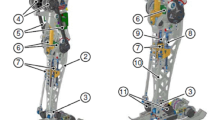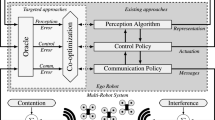Abstract
This paper presents a novel, legged robot, Abigaille-III, which is a hexapod actuated by 24 miniature gear motors. This robot uses dual-layer dry adhesives to climb smooth, vertical surfaces. Because dry adhesives are passive and stick to various surfaces, they have advantages over mechanisms such as suction, claws and magnets. The mechanical design and posture of Abigaille-III were optimized to reduce pitchback forces during vertical climbing. The robot’s electronics were designed around a Field Programmable Gate Array, producing a versatile computing architecture. The robot was reconfigured for vertical climbing with both 5 and 6 legs, and with 3 or 4 motors per leg, without changes to the electronic hardware. Abigaille-III demonstrated dexterity through vertical climbing on uneven surfaces, and by transferring between horizontal and vertical surfaces. In endurance tests, Abigaille-III completed nearly 4 hours of continuous climbing and over 7 hours of loitering, showing that dry adhesive climbing systems can be used for extended missions.
Similar content being viewed by others
References
Autumn K, Peattie A M. Mechanisms of adhesion in geckos. Integrative and Comparative Biology, 2002, 42, 1081–1090.
Kesel A B, Martin A, Seidl T. Getting a grip on spider attachment: An AFM approach to microstructure adhesion in arthropods. Smart Materials and Structures, 2004, 13, 512–518.
Seidl T, Vidoni R. Adhesion to flat surfaces: From spiders to stickers. Spider Ecophysiology, Springer, 2013, 463–473.
Zhou M, Pesika N, Zeng H, Tian Y, Israelachvili J. Recent advances in gecko adhesion and friction mechanisms and development of gecko-inspired dry adhesive surfaces. Friction, 2011, 1, 114–129.
Yu J, Chary S, Das S, Tamelier J, Pesika N S, Turner K L, Israelachvili J N. Gecko-inspired dry adhesive for robotic applications. Advanced Functional Materials, 2011, 21, 3010–3018.
Murphy M P, Aksak B, Sitti M. Gecko-inspired directional and controllable adhesion. Small, 2009, 5, 170–175.
Kwak M K, Jeong H E, Kim T, Yoon H, Suh K Y. Bio-inspired slanted polymer nanohairs for anisotropic wetting and directional dry adhesion. Soft Matter, 2010, 6, 1849–1857.
Sameoto D, Menon C. A low-cost, high-yield fabrication method for producing optimized biomimetic dry adhesives. Journal of Micromechanics and Microengineering, 2009, 19, 115002.
Unver O, Sitti M. Tankbot: A palm-size, tank-like climbing robot using soft elastomer adhesive treads. The International Journal of Robotics Research, 2010, 29, 1761–1777.
Krahn J, Liu Y, Sadeghi A, Menon C. A tailless timing belt climbing platform utilizing dry adhesives with mushroom caps. Smart Materials and Structures, 2011, 20, 1–11.
Gittens C, Goundar D, Law D, Minor J, Menon C. TBCP-I: towards the development of a timine belt based climbing platform. Proceedings of the IEEE/RA/EMB/IFMBE International Conference on Applied Bionics and Biomechanics, Venice, Italy, 2010.
Murphy M P, Sitti M. Waalbot: An agile small-scale wall-climbing robot utilizing dry elastomer adhesives. IEEE/ASME Transactions on Mechatronics, 2007, 12, 330–338.
Murphy M P, Kute C, Menguc Y, Sitti M. Waalbot II: Adhesion recovery and improved performance of a climbing robot using fibrillar adhesives. The International Journal of Robotics Research, 2010, 30, 118.
Daltorio K, Wei T E, Gorb S N, Ritzmann R E, Quinn R D. Passive foot design and contact area analysis for climbing Mini-Whegs. Proceedings of the IEEE International Conference on Robotics and Automation, Roma, Italy, 2007, 1274–1279.
Daltorio K A, Witushynsky T C, Wile G D, Palmer L R, Malek A A, Ahmad M R, Southard L, Gorb S N, Ritzmann R E, Quinn R D. A body joint improves vertical to horizontal transitions of a wall-climbing robot. Proceedings of the IEEE International Conference on Robotics and Automation, Pasedena, USA, 2008, 3046–3051.
Menon C, Sitti M. A biomimetic climbing robot based on the gecko. Journal of Bionic Engineering, 2006, 3, 115–125.
Unver O, Uneri A, Aydemir A, Sitti M. Geckobot: A gecko inspired climbing robot using elastomer adhesives. Proceedings of the IEEE International Conference on Robotics and Automation, Orlando, Florida, 2006, 2329–2335.
Kim S, Spenko M, Trujillo S, Heyneman B, Mattoli V, Cutkosky M R. Whole body adhesion: Hierarchical, directional and distributed control of adhesive forces for a climbing robot. Proceedings of the IEEE International Conference on Robotics and Automation, Roma, Italy, 2007, 1268–1273.
Menon C, Li Y, Sameoto D, Martens C. Abigaille-I: Towards the development of a spider-inspired climbing robot for space use. Proceedings of the 2nd IEEE RAS & EMBS International Conference on Biomedical Robotics and Biomechatronics, Scottsdale, USA, 2008, 384–389.
Li Y, Ahmed A, Sameoto D, Menon C. Abigaille II: Toward the development of a spider-inspired climbing robot. Robotica, 2012, 30, 79–89.
Fremerey M, Gorb S, Heepe L, Kasper D, Witte H. MaTBot: A Magnetoadhesive track robot for the inspection of artificial smooth substrates. International Symposium on Adaptive Motion of Animals and Machines, Awaji, Japan, 2011, 19–20.
Peyvandi A, Soroushian P, Lu J. A new self-loading locomotion mechanism for wall climbing robots employing biomimetic adhesives. Journal of Bionic Engineering, 2013, 10, 12–18.
Boscariol P, Henrey M, Li Y, Menon C. Optimal gait for bioinspired climbing robots using dry adhesives: A quasi-static investigation. Journal of Bionic Engineering, 2013, 10, 1–11.
Zhang H, Zhang J, Zong G, Wang W, Liu R. Sky Cleaner 3: A real pneumatic climbing robot for glass-wall cleaning. IEEE Robotics & Automation Magazine, 2006, 13, 32–41.
Qian Z Y, Zhao Y Z, Fu Z, Cao Q X. Design and realization of a non-actuated glass-curtain wall-cleaning robot prototype with dual suction cups. The International Journal of Advanced Manufacturing Technology, 2006, 30, 147–155.
Shang J, Sattar T, Chen S, Bridge B. Design of a climbing robot for inspecting aircraft wings and fuselage. Industrial Robot: An International Journal, 2007, 34, 495–502.
Elkmann N, Felsch T, Sack M, Böhme T, Hortig J, Saenz J. Modular climbing robot for service-sector applications. Industrial Robot: An International Journal, 1999, 26, 460–465.
Luk B L, Cooke D S, Galt S, Collie A A, Chen S. Intelligent legged climbing service robot for remote maintenance applications in hazardous environments. Robotics and Autonomous Systems, 2005, 53, 142–152.
Xu Z, Ma P. A wall-climbing robot for labelling scale of oil tanks volume’. Robotica, 2002, 20, 209–212.
Shen W, Gu J, Shen Y. Permanent magnetic system design for the wall-climbing robot. Applied Bionics and Biomechanics, 2006, 3, 151–159.
Palmer L R, Diller E D, Quinn R D. Design of a wall-climbing hexapod for advanced maneuvers. Proceedings of the IEEE/RSJ International Conference on Intelligent Robots and Systems, St. Louis, USA, 2009, 625–630.
Spenko M J, Haynes G C, Saunders J A, Cutkosky M R, Rizzi A A, Full R J, Koditschek D E. Biologically inspired climbing with a hexapedal robot. Journal of Field Robotics, 2008, 25, 223–242.
Hansen W R, Autumn K. Evidence for self-cleaning in gecko setae. Proceedings of the National Academy of Sciences of the United States of America, 2005, 102, 385–389.
Lee J, Fearing R S. Contact self-cleaning of synthetic gecko adhesive from polymer microfibers. Langmuir, 2008, 24, 10587–10591.
Greiner C, del Campo A, Arzt E. Adhesion of bioinspired micropatterned surfaces: Effects of pillar radius, aspect ratio, and preload. Langmuir, 2007, 23, 3495–3502.
Li Y, Sameoto D, Menon C. Enhanced compliant adhesive design and fabrication with dual-level hierarchical structure. Journal of Bionic Engineering, 2010, 7, 228–234.
Krahn J, Sameoto D, Menon C. Controllable biomimetic adhesion using embedded phase change material. Smart Materials and Structures, 2011, 20, 015014.
Jusufi A, Goldman D I, Revzen S, Full R J. Active tails enhance arboreal acrobatics in geckos. Proceedings of the National Academy of Sciences of the United States of America, 2008, 105, 4215–4219.
Vidoni R, Gasparetto A. Efficient force distribution and leg posture for a bio-inspired spider robot. Robotics and Autonomous Systems, 2011, 59, 142–150.
Mahfoudi C, Djouani K, Rechak S, and Bouaziz M. Optimal force distribution for the legs of a hexapod robot. Proceedings of the International Conference on Control Applications, Istanbul, Turkey, 2003, 657–663.
Vujicuc M. Linear Algebra Throughly Explained, 1st ed, Springer, Berlin, 2007.
Craig J J. Introduction to Robotics: Mechanics and Control, 3rd ed, Pearson Education, Upper Saddle River, 2005.
Audet C, Dennis J E. Analysis of Generalized Pattern Searches. SIAM Journal of Optimization, 2003, 13, 889–903.
Mitchell M. An Introduction to Genetic Algorithms, MIT Press, Cambridge, 1998.
Hansen J A, Gupta K C, Kazerounian S M K. Generation and evaluation of the workspace of a manipulator. The International Journal of Robotics Research, 1983, 2, 22–31.
Kroner E, Maboudian R, Arzt E. Adhesion characteristics of PDMS surfaces during repeated pull-off force measurements. Advanced Engineering Materials, 2010, 12, 398–404.
Author information
Authors and Affiliations
Corresponding author
Rights and permissions
About this article
Cite this article
Henrey, M., Ahmed, A., Boscariol, P. et al. Abigaille-III: A Versatile, Bioinspired Hexapod for Scaling Smooth Vertical Surfaces. J Bionic Eng 11, 1–17 (2014). https://doi.org/10.1016/S1672-6529(14)60015-9
Published:
Issue Date:
DOI: https://doi.org/10.1016/S1672-6529(14)60015-9




